John Updike Society board members name their top five Updike books
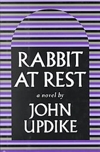
Peter J. Bailey
Piskor Professor of English Emeritus, St. Lawrence University (New York)
Author, Rabbit (Un)Redeemed: The Drama of Belief in John Updike’s Fiction; Reading Stanley Elkin; and The Reluctant Film Art of Woody Allen
- Rabbit at Rest (1990). A depressed book about a depressed man, etc.
- In the Beauty of the Lilies (1996). A beautiful historical novel exploring faith in America.
- Rabbit Is Rich (1981). The quintessential evocation of ordinary life in Pennsylvania/America.
- The Afterlife and Other Stories (1994). The stories evoking JU’s mother are among his very best.
- The Maples Stories (2009). The life and death of a marriage faithfully limned.

Marshall Boswell
Professor of English, Rhodes College (Tennessee)
Author, John Updike’s Rabbit Tetralogy: Mastered Irony in Motion
and Understanding David Foster Wallace
- Pigeon Feathers and Other Stories (1962). This is the one that started it for me, and might be the single book that prompted my career. As I told my students recently, before I’d read these stories, all the writing I had experienced had been in stereo. The prose in this book was in 5.1 Surround Sound.
- Couples (1968). Replete, lyrical, full of big themes, and yet gossipy and sexy as well, this is the brightest of all his books, I think, and the ur-text of his later adultery novels.
- Rabbit Redux (1971). It’s remarkable to look back at the high sixties, as John Barth called them, and see how few of Updike’s contemporaries were truly taking the pulse of the times. Roth, for instance, wouldn’t address the era directly until American Pastoral, which responds to this novel in fascinating ways.
- Roger’s Version (1986). This was Updike’s new novel at the time I was discovering Pigeon Feathers and Couples, and so I bought it in hardcover as a college sophomore. The combination of computer technology and Barthian theology would have been enough to sustain most novels, but this one also has the Hawthornean (Scarlet Letter) intertext, making it the most layered and artful of Updike’s novels and a possible precursor to Richard Powers’ The Gold-Bug Variations.
- Trust Me (stories) (1987). One more from that mid-‘80s first encounter with Updike, and another bright book from a peak period of Updike’s career, which includes Rabbit Is Rich, The Witches of Eastwick, and Self-Consciousness.

Biljana Dojčinović
Professor, Dept. of Comparative Literature & Theory, University of Belgrade (Serbia)
Author: Cartographer of the Modern World: The Novels of John Updike
- Roger’s Version (1986). Unreliable narrator at its best, creating a middle-class demon of a character and manipulator; author also manipulates the levels of narration and there’s an extremely fine intertextuality (connections with not only Hawthorne but with Thomas Mann’s A Magic Mountain, for instance).
- Rabbit, Run (1960). Love it for the depiction of the characters’ yearning for freedom when caught in narrow roles, for the depiction of characters’ thoughts and feelings, the way they see each other and the world, for the magnificent tragic scene of the drunk mother and also the magnificent mother of Rabbit and Kruppenbach scene, among many others.
- Rabbit Redux (1971). For the consistency in describing a changing character, open political discourse given through characters’ conversations, for the fact every act and every depiction has relevance within the book, the literary relevance, while also speaking about the actual world.
- Rabbit at Rest (1990). For convincing me that both Rabbit and I have the same memories; for bringing me back (and taking away forever) my good old friend, Harry Angstrom, at the end of the decade; for the brilliant sentences and, as always, this detailed and loving relation to the world he describes.
- Pigeon Feathers and Other Stories (1962). I love all the story collections (just as I love Rabbit Is Rich, but there are only five places here), but this is where the appreciation of Updike can begin for those who remember their youth often and with warmth. Especially the title story and those which speak about growing up, maturing, and becoming a young adult, because of the loving, detailed descriptions, because of letting the characters be confused, scared, and sad, and because Updike’s way of writing is so visual and vivid.
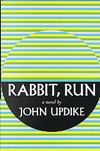
Donald J. Greiner
Carolina Distinguished Professor of English Emeritus, University of South Carolina
Author, The Other John Updike: Poems/Stories/Prose/Play; John Updike’s Novels; Adultery in the American Novels: Updike, James, Hawthorne; Comic Terror: The Novels of John Hawkes; Understanding John Hawkes; Women Enter the Wilderness: Male Bonding and the American Novel of the 1980s; Women without Men: Female Bonding and the American Novel of the 1980s; Domestic Particulars: The Novels of Frederick Busch;and Robert Frost: The Poet and His Critics
- Rabbit, Run (1960). For the “yes, but” tone of the novel, but also for the technique. I don’t believe I had read a novel written in the present tense before, though the technique is common today, especially in short fiction. I’d prefer, however, to describe the four Rabbit novels as one novel about one key character, much as The Alexandria Quartet (by Laurence Durrell) is often thought of as one novel about the same three or four characters. I am happy to report that students still get upset with Rabbit, Run.
- Of the Farm (1965). For me, this short novel is Updike’s perfect novel. On the first page, three characters drive up to visit the fourth character. On the last page, the three characters drive away after doing little more than talking during a long weekend. But what talk. Marriage/divorce; mother/son/deceased father; man/wife/child; religion/Lutheran/Karl Barth; nature/city; female/male/sex: all of Updike is there—not to mention the novel is elegantly written.
- Pigeon Feathers and Other Stories (1962). For all the obvious reasons, but especially for the last two “omnibus stories.”
- Problems and Other Stories (1979). These stories of maturity, often from the perspective of maturity recalling childhood, deeply affect me. Old age triggers memories. I am ready to run “The Egg Race” again.
- (Tie) In the Beauty of the Lilies (1996) and The Centaur (1963). In the Beauty of the Lilies is an overlooked Updike book that I predict will be “rediscovered” once readers decide not to reread, say, Rabbit, Run. The United states begins to decline at the very beginning of the so-called “American Century” as the Hollywood star usurps the heavenly star. Hard stuff for an Updike novel, much as Rabbit Redux was decades earlier. And to think that Podhoretz argued that Updike wrote like an angel but had nothing to say. The Centaur is the most moving father-and-son novel I know, a novel about a father’s sacrifice and a son’s guilt at not realizing the sacrifice until he is an adult. In Updike’s lyrical prose, the son turns the father into a myth so that he can live forever.
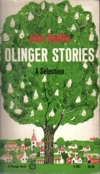
Robert M. Luscher
Emeritus Professor of Literature, University of Nebraska at Kearney
Author, John Updike: A Story of the Short Fictions
- Olinger Stories (2014). One of my favorites—perhaps not surprising, given my interest with the short story sequence—gathering the stories of that Pennsylvania “local boy” in a loose bildungsroman that, as Updike asserts in his forward, generates “new light among the shadows” as these stories are juxtaposed to form a composite. The stories are still so fresh, with JU’s verbal facility on display.
- Too Far to Go (1979) / The Maples Stories (2009). I’ve taught this book a number of times, and it never fails to engage students with its insight into a marriage, with its dynamic tensions and turbulent forces, captured in snapshots over 20 years. It’s a poignant and honest volume, displaying great insight into the Maples’ enduring relationship.
- Trust Me (stories) (1987). Perhaps no surprise that my list is top-heavy with short story volumes, but to me it shows Updike at top form in the genre, reining in the verbal pyrotechnics for which he was often criticized but still writing elegantly. Perhaps not as experimental as Museums and Women or The Music School, but still varied in form and technique, emotionally insightful, with memorable characters. “Keep breaking my heart,” Fegley says to his son in “Learn a Trade”—literally asking for his emotions to keep being awakened, which is what JU does with these stories. And while I think that “The Full Glass” from My Father’s Tears—JU’s final story—is one of Updike’s bravest, “Poker Night” treats mortality so well via its blue-collar protagonist well before that.
- Self-Consciousness (1989). Let’s not forget Updike’s memoir amidst the fiction and poetry. These six essays together touch on some of the most significant issues of being “a self forever,” a human being as well as a writer. The way Updike writes essays reminds me somewhat of Emerson, as the ideas spiral out and back in a type of organic form (one that Rebecca Solnit emulates in her essays). Who could not be moved by JU’s retrospective encounter with his hometown, his chronicle of overcoming stuttering to get the words out, or his metaphysical reflections on the title issue?
- S. (1988). Though I was initially going to include Rabbit, Run (which I find that, strangely, many students today do not truly understand), I’m going to be idiosyncratic with my final pick. I like the epistolary form (which some don’t), and have always enjoyed the portrayal of Sarah Worth’s Rabbit-like run from her former life to the commune, her energy, her delusions, her dreams, and her engaging voice as she Herzog-like sends dispatches to those from her former life, trying to make some sense of it as she does so.
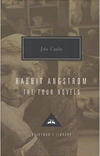
Sylvie Mathé
Professor of American Literature Emerita, Aix-Marseille University (France)
Author, John Updike: La Nostalgie de l’Amérique
- Rabbit Angstrom: The Four Novels (1995). Rabbit forever and beyond. Like Anne Roiphe, I’m a great fan, “with love and squalor.’ It reminds me of Oscar Wilde’s famous remark about the death of Lucien de Rubempré: “One of the greatest tragedies of my life,” wrote Oscar Wilde in his 1889 essay The Decay of Lying, “is the death of Lucien de Rubempré. It is a grief from which I have never been able completely to rid myself. It haunts me in my moments of pleasure. I remember it when I laugh.” Discovering “Nelson and Annabelle” in The New Yorker (“Rabbit Remembered”) some ten years after Rabbit at Rest came therefore as an epiphany of sorts.
- The Centaur (1963). Unforgettable relationship between the father and the son; unforgettable portrait of the father; unforgettable scenes (the hitchhiker, the high school). Strangely, what keeps you in awe is not so much Olympus as the humdrum world of Alton/Reading.
- Olinger Stories (2014). The core of Updike’s world, an amazing collection of epiphanies which all stick in the mind and keep haunting you even as Updike both outgrows this world and keeps returning to it time and again (The Afterlife, My Father’s Tears).
- The Maples Stories (2009). I’ve grown more attached to these stories as I have become acquainted with Mary and Updike’s children through the John Updike Society and the visit to Ipswich and the slides of the ‘60s. “Separating” in particular has taken on a special poignancy.
- (Tie) Roger’s Version (1986) and Endpoint and Other Poems (2009). Roger’s Version for its dazzling brilliance, like the two sides of the tortoise in The Encantadas, both “bright and dark”; and Endpoint, Updike’s moving farewell, his lasting words to accompany us “in the days of [our] lif[ves], [our] lif[ves], forever.”
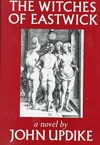
James Plath
R. Forrest Colwell Endowed Chair & Professor of English, Illinois Wesleyan University
Author, Conversations with John Updike; John Updike’s Pennsylvania Interviews; Critical Insights: Raymond Carver; Historic Photos of Ernest Hemingway; Remembering Ernest Hemingway; Critical Insights Film: Casablanca; The 100 Greatest Literary Characters; and Critical Insights: Conspiracies
- The Witches of Eastwick (1984). This quirky novel has a crackling energy and playfulness that I find irresistible. I’ve taught the book in my American Magical Realism class many times, and students really admire the way that Updike matter-of-factly uses witchcraft to enhance a story about divorcees playing Monopoly (“landing on all the properties”) in a small Rhode Island town, dabbling in various art forms until a warlock-figure arrives to stir up trouble (and humor). All the Updike themes of sex, death, and religion are here in what I consider Updike’s most “cartoonish” book in terms of tone and style: he gives “gossip” a body.
- Rabbit Is Rich (1982). Updike said he’s most interested in middles, and it seems to me that while Rabbit, Run was a beginning novel about an interesting but not-very-likable character and Rabbit at Rest had such an endgame aura of doom hanging over it, Rabbit Is Rich finds Harry over the hill but still close enough to the peak to enjoy the view. In a way, the sexual games in this novel are even more outrageous than Couples. I’m not surprised it won a Pulitzer.
- The Maples Stories (2009). I’ve often wondered why books on the so-called short story cycle don’t include Updike’s thinly disguised chronicle of his first marriage. These stories are understated and beautifully crafted, with the kind of just-right descriptions and subtle philosophical problems Updike is known for lurking just under the cool surfaces of these short but memorable stories. “Your Lover Just Called,” “Nakedness,” and “Wife-Wooing” are the stories that have stuck with me all these years.
- The Centaur (1963). This one gets a gold star just for doing something with mythology that readers had never seen before. Not quite magical realism (because there’s more than a single element of the fantastic that’s treated matter-of-factly), this groundbreaking novel was still the first time anyone dealt with mythology right there on the surface of the narrative, woven into Updike’s tale of childhood. It’s also a moving tribute to his father, and if you’re an art buff, the fictional equivalent of a painter painting a painter painting.
- (Tie) Olinger Stories (2014) and Trust Me (stories) (1987). This one really was a coin flip, with the “heads” side being Updike’s early Pennsylvania stories collected in one volume about “Olinger” (Shillington), and impact stories like “Pigeon Feathers” that deal with childhood still resonant. The “tails” side, meanwhile, is a later collection that chronicles life in middle and late middle age. You know a short story collection is strong when you remember three of the stories 30 years after you read them.
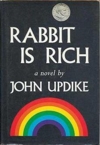
James Schiff
Professor of English, University of Cincinnati (Ohio)
Author, John Updike Revisited; Updike’s Version: Rewriting the Scarlet Letter; Updike in Cincinnati; and Understanding Reynolds Price
- Rabbit Is Rich (1982). Bourgeois bliss, the sunniest of the Rabbit novels, a great and compelling narrative about a life that’s going relatively well—how does an author pull that off?
- Too Far to Go (1979) / The Maples Stories (2009). So close to the bone in depicting the vacillations of love, desire, and marriage. Beautiful portrayal of wanting something and its opposite simultaneously.
- Rabbit at Rest (1990). Great novel about America, aging, and the body, particularly in cataloguing all the awful food we put into our bodies.
- Pigeon Feathers and Other Stories (1962). One of the all-time great short story collections, and “A&P” may not even be among the half-dozen best in the volume.
- The Witches of Eastwick (1984). Love all those novels (The Coup, Rabbit Is Rich, The Witches of Eastwick) composed during the late ‘70s and early ‘80s, when JU was clicking on all cylinders and full of energy. Feel his pleasure with this one, and the fantasy elements, the theology, the treatment of creation, death, witchcraft, gossip, music, evil, etc.—all of it feels organically right and somehow different from anything JU had written previously.

Matthew Shipe
Lecturer/Coordinator of Advanced Writing, Washington University in St. Louis
Author, John Updike and Politics
- Rabbit Is Rich (1981). For me, Rabbit Is Rich is Updike’s most complete and satisfying novel. Updike is at the height of his powers here as Harry becomes the perfect lens for considering an America that is “running out of gas.” Updike knows the world and these characters so well by this point that the novel feels fully lived in.
- Olinger Stories (2014). I was tempted to go Pigeon Feathers here, but I think this one has to get the nod as it has all the essential early Pennsylvania stories.
- Rabbit at Rest (1990). Almost as good as Rabbit Is Rich, but it gets bogged down in its middle section. The opening and closing sections, however, are brilliantly executed.
- Problems and Other Stories (1979). Updike’s best form is the short story and I’d argue that this is his best collection. You have the vital divorce stories (“Separating,” “Domestic Life in America”); postmodern experiments (the title story); and a wonderful reconsideration of the past (“Atlantises,” “Gun,” “The Egg Rce”). “Guilt-gems” is a pivotal story for understanding Updike, as is “The Egg Race” (one of his best short stories).
- (Tie) The Centaur (1963) and Roger’s Version (1986). The myth material doesn’t hold up well in The Centaur, but the portrait of the father/son relationship and the town is essential Updike.
